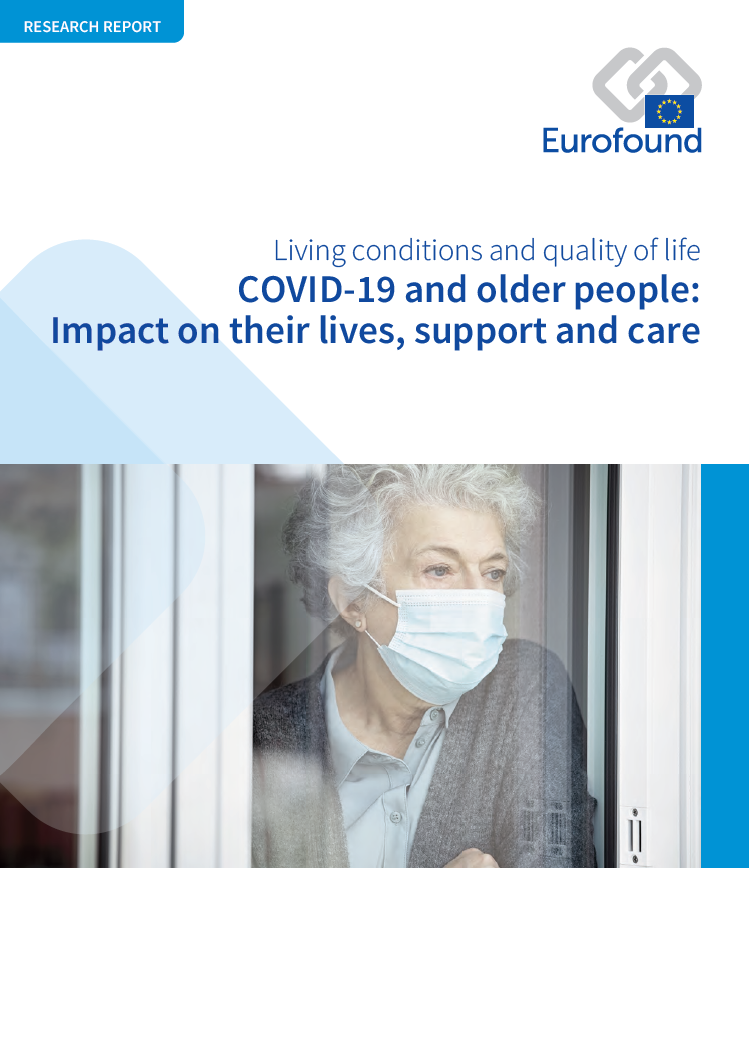
This report captures the impact of the COVID-19 crisis on the quality of life of older citizens, including the impact on their well-being, finances, employment and social inclusion. It explores the effects on the use of care services and older people’s reliance on other support. The report presents policy measures that have been implemented in EU Member States to support older people along all of the above-mentioned dimensions. These include measures to support independent living and schemes to support the labour market integration of older people or to prevent unemployment, all of which play a role in the quality of life of older citizens.
Key findings
During the COVID-19 pandemic, social contacts decreased in all age groups in the EU. Among older people, particularly worrying trends emerged in those aged 80+ where, in summer 2020, 18% of them reported feeling lonelier than before the pandemic and one-third had not left their home since the pandemic began.
Mental health deteriorated for people of all ages during the pandemic, but affected young people and the 80+ age group most severely. In summer 2020, 23% of people aged 80+ felt sad more often than before the pandemic. While access to mental health services is important to many, it is also critical to address causes of mental health problems, such as social isolation and difficulties making ends meet.
Both decreases and increases in income were less common among older people, for whom pensions proved to be a stable source of income. However, pandemic-related expenditure, such as spending on private transport and care services, caused financial difficulties, especially for low-income groups. The introduction of care services that are less dependent on income can help to improve the situation of low-income earners.
During the pandemic, the likelihood of reduced physical activity increased with age. In summer 2020, 41% of people aged 50+ went out for walks less often than before the pandemic. To encourage healthy living, address obesity – particularly common among low-income 55- to 74-year-olds – and support positive habits, it will be important to facilitate exercise and active modes of transport across communities; this can also contribute to the green transition.
Low-tech e-healthcare (by phone) facilitated access to healthcare during COVID-19, however, many older people still preferred face-to-face consultations and almost half of users aged 50+ who opted to use e-healthcare reported that it did not fully meet their needs. To ensure better e-healthcare provision in the future, a closer alignment with people’s needs will be required, as well as an acknowledgement that e-healthcare has limitations, especially in the provision of more demanding forms of care.
The report contains the following list of figures.
- Figure 1: Changes to health since the start of the pandemic, by age group and gender, summer 2020, EU (%)
- Figure 2: Feeling sad or depressed more often than before the pandemic, by age group and gender, summer 2020, EU (%)
- Figure 3: Risk of depression, by age group, EU (%)
- Figure 4: Going out for walks more or less often than before the pandemic, by age group (50+), summer 2020, EU (%)
- Figure 5: Social contacts, by age group, summer 2020, EU (%)
- Figure 6: In-person and remote contacts at least weekly, by age group, summer 2020, EU (%)
- Figure 7: Loneliness, by age group, EU (%)
- Figure 8: Changes in working hours, by age group, spring and summer 2020, EU (%)
- Figure 9: Teleworking, by age group, spring and summer 2020, EU (%)
- Figure 10: Work–life conflicts among workers, by gender and age group, EU (%)
- Figure 11: Informal care for more than five hours a week, by gender and age group, EU (%)
- Figure 12: Volunteering for over five hours a week during the pandemic, by gender and age group, EU (%)
- Figure 13: Reduction in household income of over 10%, by age group, summer 2020, EU (%)
- Figure 14: Low levels of savings, by age group, EU (%)
- Figure 15: Difficulty making ends meet, by age group, EU (%)
- Figure 16: Expectations: financial situation in three months’ time, by age group, EU (%)
- Figure 17: Help from people outside the home with obtaining necessities, by age group, summer 2020, EU (%)
- Figure 18: Medical care use since the start of the pandemic, by age group, spring 2021, EU (%)
- Figure 19: Importance of reasons for unmet healthcare needs since the start of the pandemic, by age group, summer 2020 and spring 2021, EU
- Figure 20: Types of unmet healthcare need, by age group, spring 2021, EU (%)
- Figure 21: Healthcare or health insurance arrears, by age group, EU (%)
- Figure 22: Extent to which e-healthcare met users’ needs, by age group, 2021, EU (%)
- Number of pages
-
92
- Reference nº
-
EF21053
- ISBN
-
978-92-897-2244-5
- Catalogue nº
-
TJ-03-21-504-EN-N
- DOI
-
10.2806/028438
- Permalink
Cite this publication
Eurofound (2022), COVID-19 and older people: Impact on their lives, support and care, Publications Office of the European Union, Luxembourg.
